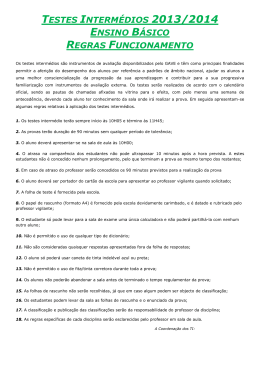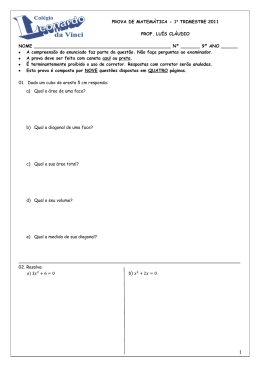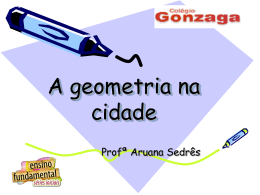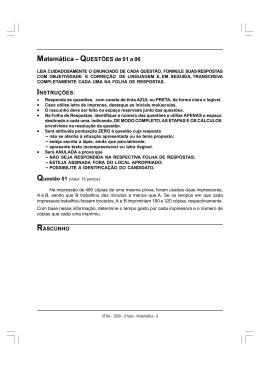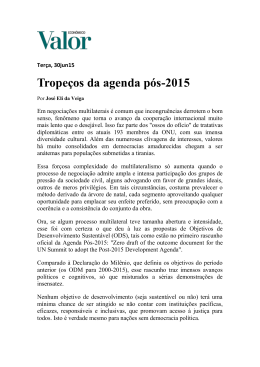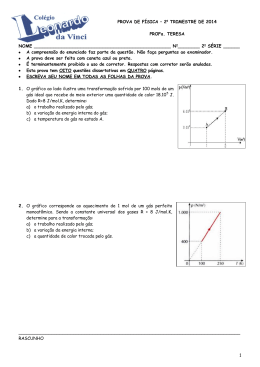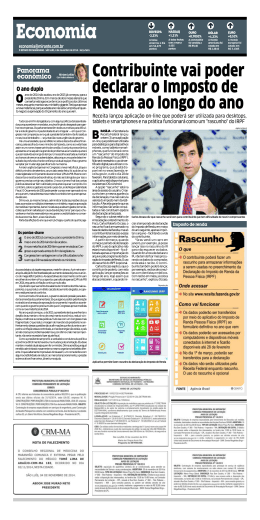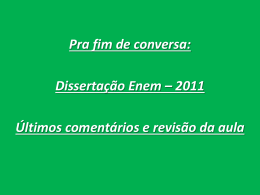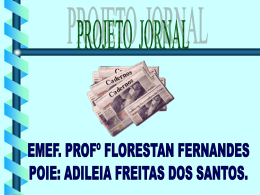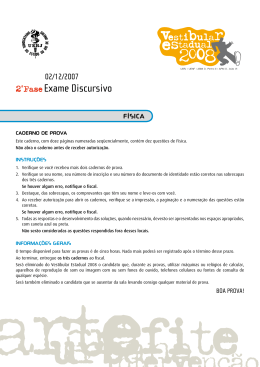INSTRUÇÕES PARA A REALIZAÇÃO DA PROVA PROVA TIPO SEGUNDA FASE 1. Nesta prova, você deverá responder a 18 questões. 2. Cada questão vale 4 pontos. 3. No caderno de respostas, você encontrará espaços numerados de 1 a 18, para responder às questões. 4. Nas matérias de exatas, é imprescindível que a resolução inclua alguma breve explicação, um diagrama e/ou algumas equações que permitam avaliar a linha de raciocínio. 5. A duração total da prova é de 4 horas e o tempo mínimo de permanência em sala é de 2 horas. DIDATIKA vestibulares 6. A prova deve ser feita com caneta azul ou preta. s14E12dissert20092014 BOA PROVA DIDATIKA Vestibulares S I M U L A D O Texto para as questões 1 e 2. AWARD - WINNING KANGAROO CARE Skin-to-skin contact creates gentles communication A touch. A feel. A heartbeat. A warm hug. Whether a newborn is two pounds or eight pounds, skin-to skin contact proves to be a nurturing strength between parent and baby in the first days of life. Similar to the way a kangaroo keeps its young close to its body, Kangaroo Care or K Care is the practice of “pouching” an infant, diaper-clad and blanketed, against a parents bare chest. This special bonding between parent and newborn has been found to reduce parental stress, promotes confidence in the ability to care for the infant and improves infant health, especially in pre-term babies. In Mount Sinai Medical Center’s Schwartz Neonatal Intensive Care Unit, 15 neonates and their families have benefited from K Care. Patricia Messmer, director of nursing research at Mount Sinai, Joyce Wells- Gentry, nursing administrative supervisor, and Suzanne Rodriguez, along with a team of nurses and doctors, are studying the effects of K Care on pre-term infants as well as parents’ attitudes toward their infants. Earlier studies have credited K Care with shorter hospital stays, greater confidence on the part of the mothers in their abilities to monitor their babies, less crying, longer sleep periods, greater weight gain, and improved lactation and decreased oxygen requirements. “Preliminary data analysis indicates a significant increase in sleep time during K Care for these infants as compared to the infants not receiving K Care”, Rodriguez Confirms. Results also indicate that during K Care, the infants experience fewer oxygen requirements and have fewer breathing difficulties. “Many parents have commented that their infants are more relaxed during K Care”, Messmer adds. “Mothers and fathers are very positive about the experience”. Miami Herald Medical Reports - adapted UFMG 1. Responda em Português. a) O que é Kangaroo Care? b) Quais as vantagens do seu uso? RASCUNHO RASCUNHO RASCUNHO RASCUNHO RASCUNHO RASCUNHO RASCUNHO RASCUNHO RASCUNHO RASCUNHO Quadro destinado à resposta da questão. Textos escritos fora deste quadro (ou à lápis) não serão considerados pelo professor. Simulado - 3 DIDATIKA Vestibulares S I M U L A D O 2. Responda em Português. a) Que informação o texto traz quanto à relação entre o uso do Kangaroo Care e dificuldades respiratórias? b) Atribua significado a palavra “pouching” no texto. Explicite-a. RASCUNHO RASCUNHO RASCUNHO RASCUNHO RASCUNHO RASCUNHO RASCUNHO RASCUNHO RASCUNHO RASCUNHO Quadro destinado à resposta da questão. Textos escritos fora deste quadro (ou à lápis) não serão considerados pelo professor. Simulado - 4 DIDATIKA Vestibulares S I M U L A D O Texto para as questões 3 e 4. A REVOLUTION IN BRAIN EVOLUTION? In a study that refutes a century of popular belief about the brain, scientists have found that humans are not necessarily stuck with the number of brain cells they were born with after all. Researchers from Princeton University discovered that new neurons are continually added to the cerebral cortex of adult monkeys, which, if true for humans, could one day lead to new therapies for memory loss, brain damage, and diseases like Alzheimer’s. “The monkey is fundamentally like the human”, said psychology professor Charles Gross, who conducted the study with associate psychology professor Elizabeth Gould. “There is no way that this can’t go on in humans. It’s inconceivable that it doesn’t”. Gould and Gross found that neurogenesis - the formation of new neurons or nerve cells - takes place in several regions of a monkey’s cerebral cortex, the part of the brain that is believed crucial for thinking, decisionmaking, as well as understanding and learning about the world. For the better part of the last century, neuroscientists have believed that the brain, unlike other organs, did not grow new cells or repair itself. “It’s always been that you’re born with all that you’ll ever have”, said William Greenough, director of the neuroscience program at the Beckman Institute at the University of Illinois. “We’ve always argued that the adult brain was not capable of normal cell proliferation”. But prior studies proved that neurogenesis does in fact occur in the brains of monkeys, but only in the older, more primitive parts of the brain, like the olfactory system, or the hippocampus, which is thought to control aspects of memory formation. Despite that new evidence, however, many scientists believed that any formation of new neurons in the adult brain had to be an aberration and that the structure of the brain was stable and unchanging. While the results of the study could lead to theoretical changes in neuroscience, scientists caution that the formation of new neurons has not been proven in humans yet, and future applications for cell replenishment and repair are still a long way off. www.wired.com/news/technology - adapted UFTM 3. Responda em Português. a) Quem são Charles Gross e Elizabeth Gould? b) As descobertas feitas por Gross e Gould em macacos adultos poderão um dia serem aplicadas em humanos? Por quê? RASCUNHO RASCUNHO RASCUNHO RASCUNHO RASCUNHO RASCUNHO RASCUNHO RASCUNHO RASCUNHO RASCUNHO Quadro destinado à resposta da questão. Textos escritos fora deste quadro (ou à lápis) não serão considerados pelo professor. Simulado - 5 DIDATIKA Vestibulares S I M U L A D O 4. Responda em Português. a) Com base na leitura do texto defina neurogênese cerebral. b) Complete: O estudo de Gross e Gould contradiz a ideia de que a estrutura cerebral é __________ . RASCUNHO RASCUNHO RASCUNHO RASCUNHO RASCUNHO RASCUNHO RASCUNHO RASCUNHO RASCUNHO RASCUNHO Quadro destinado à resposta da questão. Textos escritos fora deste quadro (ou à lápis) não serão considerados pelo professor. Simulado - 6 DIDATIKA Vestibulares S I M U L A D O 5. MURPHY WAS A PERFECTIONIST As the son of the man whose name is attached to ‘Murphy’s law’, I want to thank you for accurately and respectfully identifying the origin of this ‘law’ in your recent article (The Science of Murphy’s Law - by Robert A. J. Matthews, April). My father was an avid reader of Scientific American, and I can assure you that were he still alive, he would have written to you himself, thanking you for a more serious discussion of Murphy’s Law than the descriptions on the posters and calendars that treat it so lightly. Yet as interesting as the article is, I suggest that the author may have missed the point of Murphy’s Law. Matthews describes the law in terms of the probability of failure. I would suggest, however, that Murphy’s law actually refers to the Certainty of failure. It is a call for determining the likely causes of failure in advanced and acting to prevent a problem before it occurs. In the example of flipping toast, my father would not have stood by and watched the slice fall onto its buttered side. Instead he would have figured out a way to prevent the fall or at least ensure that the toast would fall butter-side up. Murphy and his fellows engineers spent years testing new designs of devices related to aircraft pilot safety or crash survival when there was no room for failure (for example, they worked on supersonic jets and Apollo landing craft). They were not content to rely on probabilities for their success. Because they knew that things left to chance would definitely fail, they went to painstaking efforts to ensure success. Edward A. Murphy III - Sausalito, California - Scientific American After receiving more than 362 intact issues of Scientific American, I received the April issue - with the article on Murphy’s Law - that was not only assembled incorrectly by the printer but also damaged by the U.S. Post Office during delivery. My teenage daughter is taking this magazine into her science class to talk about Murphy’s Law. The condition of this issue is an excellent example for her presentation. Brad Whitney - Anaheim, California - Scientific American a) O que deu origem a esses dois textos? b) O segmento texto afirma: ‘the condition of this issue is an excellent example for her presentation’. Explique por quê. RASCUNHO RASCUNHO RASCUNHO RASCUNHO RASCUNHO RASCUNHO RASCUNHO RASCUNHO RASCUNHO RASCUNHO Quadro destinado à resposta da questão. Textos escritos fora deste quadro (ou à lápis) não serão considerados pelo professor. Simulado - 7 DIDATIKA Vestibulares S I M U L A D O 6. MIGRATION: ‘A FORCE OF HISTORY’ I was born in one continent, moved to a second and settled in a third. Asia, Africa and Europe; Sri Lanka, Ghana and Britain. They are stepping stones to a better life, landmarks along the journey of one migrant family. Our motivation for leaving the land of our birth over 40 years ago was no different to the reason so many make similar journeys today. The fact that these latter-day migrants are willing to risk so much underlines a fundamental truth about migration - the movement of people from poor and failing states to rich and stable ones is as inevitable as water running downhill. If water is a force of nature, then migration is a force of history. The challenge is not to try to stop it but how to manage it. Historically, the net effect of migration has been a benign one. Where would America be without the unparalleled movement of Irish people in the mid-to-late 19th Century? Where would modern Australia be if it had continued to rely solely on the flow of people from the “mother” country. When I discuss migration with people who have a rather different take on it, there is always that comical moment when they realise that - despite my English tones - I am an immigrant. An embarrassed “oh but you are different” is the best they can offer to hide their prejudice. My answer is always the same. There is just as much chance that the timid Kosovan child who enrols in a school today will one day go on to read the news on the BBC. I am where I am because I’ve been able to take advantage of the opportunities offered by a Britain at its best - a land of hope that is open and confident. To deny these chances to a new generation of migrants would be an injustice to the individuals concerned but, more important, it would mark a profound loss of faith in our nation’s place in this new century of globalisation. by BBC news presenter George Alagiah - from www.bbc.co.uk - adapted Migration: the movement of large numbers of people / Immigration: the process of coming to live permanently in a country that is not your own Responda em Português. a) Por que o autor compara migração com água corrente? E, também, por que se compara com uma criança de Kosovo? b) Alagiah diz que migração tem um efeito positivo. Que fatos ele menciona para provar seu ponto de vista? Qual o lugar que ele parece considerar sua verdadeira nação? RASCUNHO RASCUNHO RASCUNHO RASCUNHO RASCUNHO RASCUNHO RASCUNHO RASCUNHO RASCUNHO RASCUNHO Quadro destinado à resposta da questão. Textos escritos fora deste quadro (ou à lápis) não serão considerados pelo professor. Simulado - 8 DIDATIKA Vestibulares S I M U L A D O 7. Observe os mapas a seguir. Cerrado Caatinga Floresta Amazônica Mata Atlântica Campos Vegetação Litorânea Vegetação do Pantanal Mata de Araucária Mata dos Cocais Lopo Homem e Diogo Homem - Atlas Miller, 1519 (detalhe) Brasil - Vegetação - IBGE Atlas Geográfico Escolar, 2009 - adaptado a) Identifique duas diferenças significativas entre os mapas, quanto à forma de representação cartográfica. b) Qual era o principal objetivo de cada mapa, considerando os diferentes contextos históricos em que foram criados? RASCUNHO RASCUNHO RASCUNHO RASCUNHO RASCUNHO RASCUNHO RASCUNHO RASCUNHO RASCUNHO RASCUNHO Quadro destinado à resposta da questão. Textos escritos fora deste quadro (ou à lápis) não serão considerados pelo professor. Simulado - 9 DIDATIKA Vestibulares S I M U L A D O 8. A formação histórica do atual Estado do Rio Grande do Sul está intrinsecamente relacionada à questão fronteiriça existente entre os domínios das duas coroas Ibéricas na América meridional. Desde o século XVIII, esta região foi cenário de constantes disputas territoriais entre diferentes agentes sociais. Atritos que não estiveram restritos apenas às lutas travadas entre luso-brasileiros e hispano-americanos pelo domínio do Continente do Rio Grande. Eduardo Santos Neumann - A Fronteira Tripartida -, Luiz Alberto Grijó (e outros) Capítulos de História do Rio Grande do Sul - Porto Alegre: Editora da UFRGS, 2004 - pág. 25 - adaptado a) Caracterize a questão fronteiriça, mencionada no texto. b) Quais são as principais diferenças e semelhanças entre a organização socioeconômica do Rio Grande colonial e a de regiões açucareiras, como Bahia e Pernambuco, na mesma época? RASCUNHO RASCUNHO RASCUNHO RASCUNHO RASCUNHO RASCUNHO RASCUNHO RASCUNHO RASCUNHO RASCUNHO Quadro destinado à resposta da questão. Textos escritos fora deste quadro (ou à lápis) não serão considerados pelo professor. Simulado - 10 DIDATIKA Vestibulares S I M U L A D O 9. 1549 e 1763 são os anos do estabelecimento de Salvador e Rio de Janeiro, respectivamente, como capitais da área que viria a ser o Brasil. Em 1960, a terceira capital foi inaugurada. Em relação ao estabelecimento das capitais, responda: a) Quais os objetivos políticos do estabelecimento das duas primeiras capitais? b) Considerando a possibilidade de simulação de um Brasil Moderno que Brasília deveria encarnar, compare com a apresentação dos PACs dos últimos governos do país. RASCUNHO RASCUNHO RASCUNHO RASCUNHO RASCUNHO RASCUNHO RASCUNHO RASCUNHO RASCUNHO RASCUNHO Quadro destinado à resposta da questão. Textos escritos fora deste quadro (ou à lápis) não serão considerados pelo professor. Simulado - 11 DIDATIKA Vestibulares S I M U L A D O 10. “Embora a origem da Reforma de Lutero se deva a uma experiência pessoal, ela refletiu, na verdade, o estado de espírito comum a muitos seguidores da Igreja Romana. De fato, a iniciativa da livre interpretação da Bíblia deve ser compreendida como mais uma das muitas manifestações típicas do individualismo do homem renascentista”. Carmen Peris, Glória Vergés e Oriol Vergés - El Renascimiento - Barcelona: Parramón Ediciones, s/d, pág. 32 a) Quais foram as relações culturais da Reforma Protestante com o Renascimento Cultural? b) Por que a livre interpretação da Bíblia era criticada pelo alto clero medieval? RASCUNHO RASCUNHO RASCUNHO RASCUNHO RASCUNHO RASCUNHO RASCUNHO RASCUNHO RASCUNHO RASCUNHO Quadro destinado à resposta da questão. Textos escritos fora deste quadro (ou à lápis) não serão considerados pelo professor. Simulado - 12 DIDATIKA Vestibulares S I M U L A D O 11. O pensamento iluminista do século 18 tem na Enciclopédia, dirigida por Diderot e D’Alembert, uma obra de 35 volumes, editada entre 1751 e 1780, que reúne a totalidade dos conhecimentos da época. Por usarem os princípios da razão para questionar os fundamentos da sociedade em que viviam, os enciclopedistas foram considerados defensores de um pensamento revolucionário. a) Quais foram as principais características do pensamento das luzes? b) Contra quais valores da época se dirigiam as críticas dos pensadores iluministas? RASCUNHO RASCUNHO RASCUNHO RASCUNHO RASCUNHO RASCUNHO RASCUNHO RASCUNHO RASCUNHO RASCUNHO Quadro destinado à resposta da questão. Textos escritos fora deste quadro (ou à lápis) não serão considerados pelo professor. Simulado - 13 DIDATIKA Vestibulares S I M U L A D O 12. Entre 1776 e 1848, o movimento democrático liberal prossegue seu curso na América do norte e na Europa e já em meados do século XIX está extenuado. Estas datas não foram escolhidas arbitrariamente. O ano de 1776 foi a data da publicação da Riqueza das Nações de Adam Smith e 1848 da publicação do Manifesto comunista de Marx e Engels. a) Cite e caracterize três movimentos democrático-liberais que ocorreram no período entre 1776 e 1848. b) Comente e compare os principais elementos das doutrinas formuladas por Adam Smith em a Riqueza das Nações e por Marx e Engels no Manifesto Comunista. RASCUNHO RASCUNHO RASCUNHO RASCUNHO RASCUNHO RASCUNHO RASCUNHO RASCUNHO RASCUNHO RASCUNHO Quadro destinado à resposta da questão. Textos escritos fora deste quadro (ou à lápis) não serão considerados pelo professor. Simulado - 14 DIDATIKA Vestibulares S I M U L A D O 13. A figura representa um trapézio ABCD de bases AB e CD, inscrito em uma circunferência cujo centro O está no interior do trapézio. Sabe-se que AB = 4, CD = 2 e AC = 3 2 . D C O A B a) Determine a altura do trapézio. b) Calcule o raio da circunferência na qual ele está inscrito. RASCUNHO RASCUNHO RASCUNHO RASCUNHO RASCUNHO RASCUNHO RASCUNHO RASCUNHO RASCUNHO RASCUNHO Quadro destinado à resposta da questão. Textos escritos fora deste quadro (ou à lápis) não serão considerados pelo professor. Simulado - 15 DIDATIKA Vestibulares S I M U L A D O 14. λ1) x2 + y2 = x e (λ λ2) x2 + y2 = y, calculando o raio e o centro das a) Identifique as circunferências de equações (λ mesmas. Esboce seus gráficos. b) Determine os pontos P e Q de intersecção dessas circunferências e mostre que as retas a elas tangentes em cada um desses pontos são perpendiculares entre si. RASCUNHO RASCUNHO RASCUNHO RASCUNHO RASCUNHO RASCUNHO RASCUNHO RASCUNHO RASCUNHO RASCUNHO Quadro destinado à resposta da questão. Textos escritos fora deste quadro (ou à lápis) não serão considerados pelo professor. Simulado - 16 DIDATIKA Vestibulares S I M U L A D O 15. O consumo mensal de água nas residências de uma pequena cidade é cobrado como se descreve a seguir. Para um consumo mensal de até 10 metros cúbicos, o preço é fixo e igual a R$ 20,00. Para um consumo superior, o preço é de R$ 20,00 acrescidos os R$ 4,00 por metro cúbico consumido acima dos 10 metros cúbicos. Considere C(x) a função que associa o gasto mensal com o consumo de x metros cúbicos de água. a) Esboce o gráfico da função C(x) no plano cartesiano para x entre 0 e 30. b) Para um consumo mensal de 4 metros cúbicos de água, qual é o preço efetivamente pago por metro cúbico? E para um consumo mensal de 25 metros cúbicos? RASCUNHO C 100 90 70 60 50 40 30 20 10 5 5 10 15 20 25 30 x RASCUNHO RASCUNHO RASCUNHO 0 RASCUNHO RASCUNHO 80 RASCUNHO RASCUNHO RASCUNHO RASCUNHO Quadro destinado à resposta da questão. Textos escritos fora deste quadro (ou à lápis) não serão considerados pelo professor. Simulado - 17 DIDATIKA Vestibulares S I M U L A D O 16. Sejam os números complexos z = x + yi com x e y reais e i2 = -1. a) Determine Re ( 1 1 ) e Im ( ), z ≠ 0. z z b) Encontre a equação dos pontos correspondentes aos complexos z, z ≠ 0 no plano complexo, tais que Re ( 1 1 )= . 8 z RASCUNHO RASCUNHO RASCUNHO RASCUNHO RASCUNHO RASCUNHO RASCUNHO RASCUNHO RASCUNHO RASCUNHO Quadro destinado à resposta da questão. Textos escritos fora deste quadro (ou à lápis) não serão considerados pelo professor. Simulado - 18 DIDATIKA Vestibulares S I M U L A D O 17. Dizemos que uma sequência de números reais não nulos (a1, a2, a3, a4, ...) é uma progressão harmônica 1 1 1 1 se a sequência dos inversos ( a , a , a , a , ...) é uma progressão aritmética (PA). 1 2 3 4 a) Dada a progressão harmônica ( 2 4 1 , , , ...) encontre o seu sexto termo. 5 9 2 2 ac b) Sejam a, b e c termos consecutivos de uma progressão harmônica. Verifique que b = a + c . RASCUNHO RASCUNHO RASCUNHO RASCUNHO RASCUNHO RASCUNHO RASCUNHO RASCUNHO RASCUNHO RASCUNHO Quadro destinado à resposta da questão. Textos escritos fora deste quadro (ou à lápis) não serão considerados pelo professor. Simulado - 19 DIDATIKA Vestibulares S I M U L A D O 18. Em seu trabalho, João tem 5 amigos, sendo 3 homens e 2 mulheres. Já sua esposa Maria tem, em seu trabalho, 4 amigos (distintos dos de João), sendo 2 homens e 2 mulheres. Para uma confraternização, João e Maria pretendem convidar 6 dessas pessoas, sendo exatamente 3 homens e 3 mulheres. Determine de quantas maneiras eles podem convidar essas pessoas: a) Dentre todos os seus amigos no trabalho. b) De forma que cada um deles convide exatamente 3 pessoas, dentre seus respectivos amigos. RASCUNHO RASCUNHO RASCUNHO RASCUNHO RASCUNHO RASCUNHO RASCUNHO RASCUNHO RASCUNHO RASCUNHO Quadro destinado à resposta da questão. Textos escritos fora deste quadro (ou à lápis) não serão considerados pelo professor. Simulado - 20 DIDATIKA Vestibulares S I M U L A D O QUESTÕES x PROFESSOR 01. Inglês 02. Inglês 03. Inglês 04. Inglês 05. Inglês 06. Inglês 07. História 08. História 09. História 10. História 11. História 12. História 13. Matemática 14. Matemática 15. Matemática 16. Matemática 17. Matemática 18. Matemática - prof ª. Sônia - prof ª. Sônia - prof ª. Sônia - prof ª. Sônia - prof ª. Sônia - prof ª. Sônia - prof. Malcon - prof. Malcon - prof. Malcon - prof. Geraldo Teruya - prof. Geraldo Teruya - prof. Geraldo Teruya - prof. Rodrigo - prof. Eloy - prof. José Roberto - prof. Fernando - prof. Badin - prof. Badin Simulado - 21
Download
